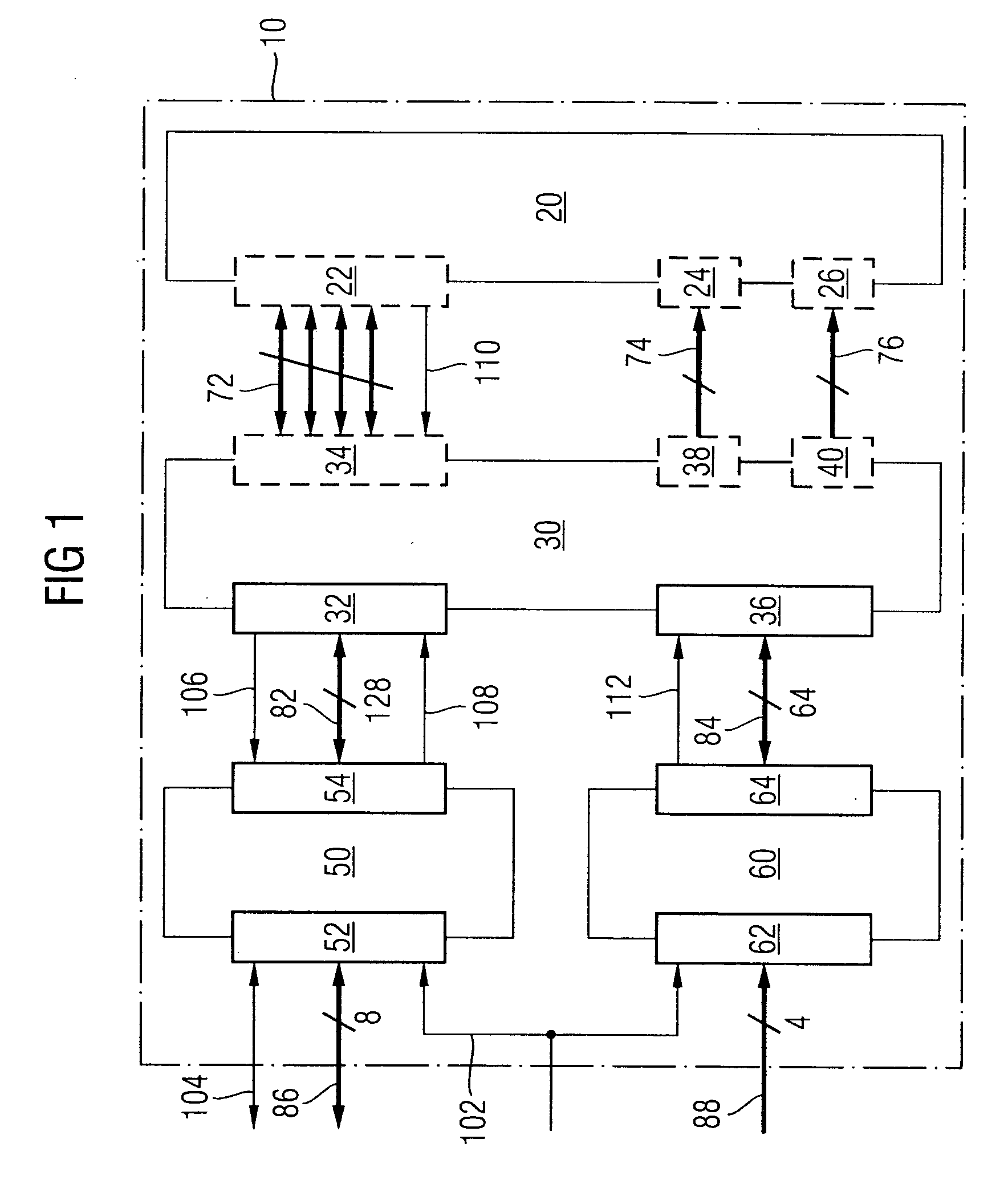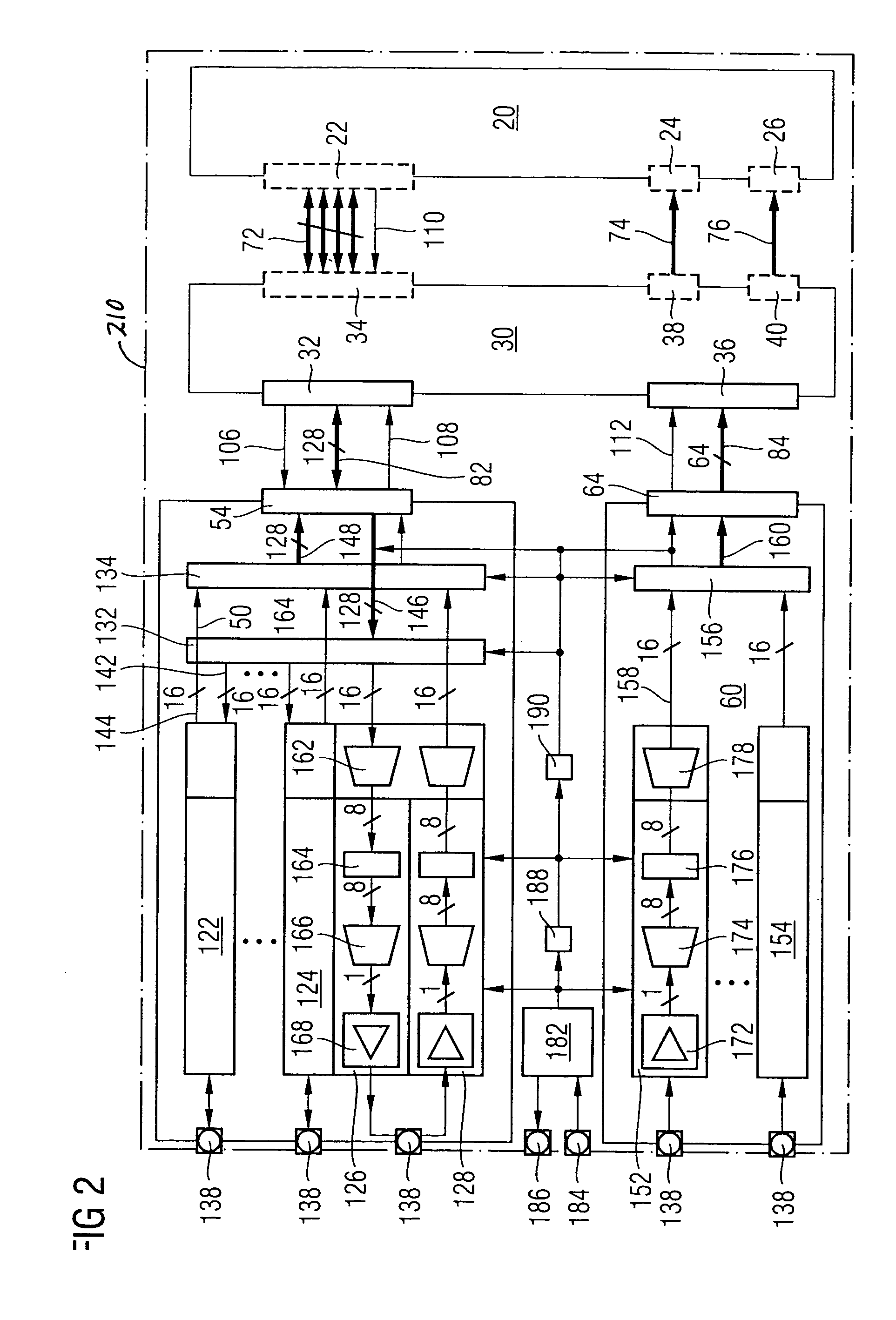Memory device having components for transmitting and receiving signals synchronously
a memory device and synchronous transmission technology, applied in the direction of information storage, static storage, digital storage, etc., can solve the problems of high error-prone internal data transfer and vice versa low bit rate in the inpuvoutput section, and increase the risk of error with the factor of conversion, so as to improve the exchange of signals between the interfaces of the components or sections of the memory device, the effect of improving the security, stable and reliabl
- Summary
- Abstract
- Description
- Claims
- Application Information
AI Technical Summary
Benefits of technology
Problems solved by technology
Method used
Image
Examples
first embodiment
[0024]FIG. 1 is a schematic circuit diagram of a memory device 10 according to the present invention. The memory device 10 comprises an array 20 of memory cells. The memory cells may be dynamic memory cells, and each cell may include a storage capacitor and an access transistor connecting the storage capacitor to a bit line, the access transistor being controlled via a word line. Alternatively, the memory cells of the array 20 may be any other kind of dynamic or static memory cells.
[0025] The array 20 of memory cells is provided with a first interface 22 for receiving data, or data signals, to be stored in the memory cells of the array 20 and for transmitting data, or data signals, read from memory cells of the array 20. Further, the array 20 is provided with second and third interfaces 24, 26 for receiving addresses, or address signals, of memory cells in which data are to be stored or from which data are to be read. In one embodiment, the second interface 24 receives a column addr...
second embodiment
[0045]FIG. 2 is a schematic circuit diagram of a memory device 210 according to the present invention. This memory device 210 is similar to the memory device 10 described above with reference to FIG. 1. In contrast to FIG. 1, the internal configuration of the input / output section 50, 60 is displayed.
[0046] The first part 50 of the input / output section comprises eight lanes with identical inner structure. Two of the lanes, the first lane 122 and the seventh lane 124, are displayed merely as rectangles. As shown in detail with regard to the eighth lane, it is displayed that each lane consists of a transmitting circuit 126 and a receiving circuit 128.
[0047] Furthermore, the first part 50 of the input / output section comprises a first FIFO memory 132 and a second FIFO memory 134. The first part 50 of the input / output section further comprises eight contact pads 138. Each of the contact pads 138 is connected to one of the lanes 122, 124. From the eighth lane, it is shown that in each lan...
fourth embodiment
[0077] In the fourth embodiment, the transfer of command, address and data signals from the memory controller or any other external circuit to the second part 60 of the input / output section, from there to the control logic 30 and from the control logic 30 to the array 20 of memory cells, is controlled by clock signals which are transmitted parallel to the command, address and data signals via clock lines 102, 112, 114. The clock signal transferred via the clock line 112 from the second part 60 of the input / output section to the control logic 30 is the same as or is derived by clock division from the clock signal transferred from the memory controller to the input / output section 50, 60 via the clock line 102. The clock transferred from the control logic 30 to the array 20 of memory cells via the clock line 114 is the same as or derived by clock division from the clock transferred from the input / output section 50, 60 to the control logic 30 via the clock line 112. The whole control lo...
PUM
 Login to View More
Login to View More Abstract
Description
Claims
Application Information
 Login to View More
Login to View More - R&D
- Intellectual Property
- Life Sciences
- Materials
- Tech Scout
- Unparalleled Data Quality
- Higher Quality Content
- 60% Fewer Hallucinations
Browse by: Latest US Patents, China's latest patents, Technical Efficacy Thesaurus, Application Domain, Technology Topic, Popular Technical Reports.
© 2025 PatSnap. All rights reserved.Legal|Privacy policy|Modern Slavery Act Transparency Statement|Sitemap|About US| Contact US: help@patsnap.com



